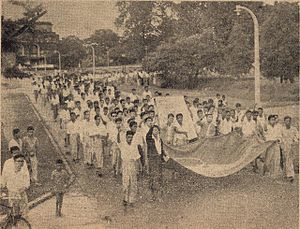
Back ဆဲဗင်းဂျူလိုင် ကျောင်းသား အရေးတော်ပုံ Burmese การประท้วงที่มหาวิทยาลัยย่างกุ้ง พ.ศ. 2505 Thai 1962年仰光大學抗議事件 Chinese
| 1962 Rangoon University protests | |
|---|---|
 7 July 1962 Peaceful march from Convocation Hall on Chancellor Road | |
| Date | 7 July 1962 – 1963 |
| Location | |
| Caused by | Unjust university rules |
| Methods | Civil resistance, demonstrations, nonviolent resistance |
| Resulted in | Violent suppression by the government |
| Casualties | |
| Death(s) | 15–100+[1][2] |
The 1962 Rangoon University protests, also known as the 7 July Student Uprising (Burmese: ဆဲဗင်းဂျူလိုင် ကျောင်းသား အရေးတော်ပုံ), were a series of marches, demonstrations, and protests against stricter campus regulations, the end of the system of university self-administration, and the policy of the new military regime of General Ne Win. The main events took place in Rangoon, Burma (present-day Yangon, Myanmar), from 7 to 8 July 1962. On 7 July the military regime violently suppressed a student demonstration at Rangoon University attended by some 5,000 students. This resulted in the deaths of more than one hundred, and the arrest of more than 6,000 students according to unofficial sources. However, official government statements put the death toll at 15. In the morning hours of the next day, the military regime blew up the historic Rangoon University Students' Union (RUSU) building, which had been the symbol of the anti-colonial nationalism struggle since the 1920s.
The reaction of the military regime disclosed for the first time its new tough stance against all regime opponents as part of implementing the new state ideology, the Burmese Way to Socialism, which included bringing "almost all of Burma's political, social, and economic life under strict military control".[3] It also demonstrated that the effective suppression of student activism and the de-politicisation of the universities ranked high among the strategic goals of the new government. Students had been in the vanguard of the Burmese anti-colonial nationalist struggle ever since the first student protests in Burma began in 1920. Although the regime had been successful in ending the student protests, the violent reaction nonetheless undermined its support among the broader population and created a symbolic focal point for later student protests in the following decades.
In the aftermath of the violent crackdown on the student protests, the Government of Ne Win immediately closed all universities for four months and sent all students home. Broad institutional reforms introduced by the 1964 University Education Act, then, brought Burma's universities under strict government control and profoundly hampered cohesive open student activism in subsequent decades. In this respect, the result of the 1962 Rangoon University protests ushered a new era of underground student activism in which open mass student involvement in national politics erupted only sporadically, most prominently during the student protests of the mid-1970s and during the 8888 Uprising in 1988.
The reverberation of the events on 7–8 July 1962 can be felt to this day. General Ne Win prominently illustrated the continuing symbolic power associated with the protests when he referred in his departure speech in 1988 to the destruction of the RUSU building as "one of the key episodes"[4] during his time in power. As recently as 2012 around 14 persons were "taken into custody by local authorities ... to prevent them from going ahead with planned events to mark the 50th anniversary" of the 7 July incidents.[5]
- ^ Wai, Ye (7 July 2008). "Burma: On the Occasion of 7th July Anniversary". Asian Tribune. Archived from the original on 9 July 2018. Retrieved 20 January 2014.
- ^ Zaw, Aung (24 August 2004). "Sein Lwin 'The Butcher of Rangoon' Dies in Poverty". The Irrawaddy. Archived from the original on 1 February 2014. Retrieved 20 January 2014.
- ^ Clapp 2007, p. 3
- ^ Charney 2009, p. 116
- ^ Cite error: The named reference
:24was invoked but never defined (see the help page).